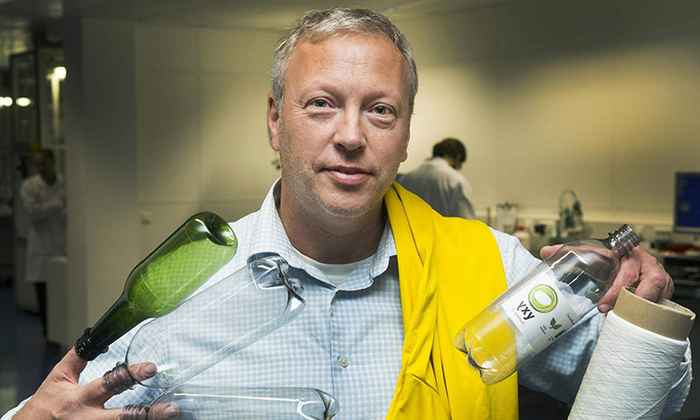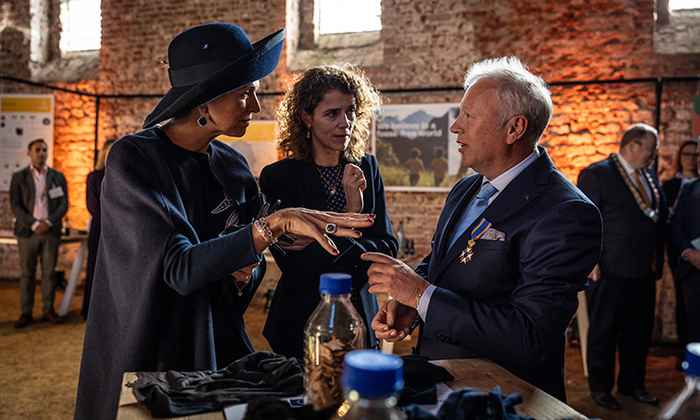“The failure to reach a global agreement on plastics makes it virtually impossible to achieve our CO2 targets”
Professor Gert-Jan Gruter on how the petrochemical lobby torpedoed the UN plastics summit in Geneva
18 August 2025

The negotiations were closely followed by Gert-Jan Gruter, professor of Industrial Sustainable Chemistry at the University of Amsterdam, Chief Technology Officer of chemical company Avantium and knighted last year for his extraordinary contributions to sustainable chemistry and his commitment to innovation and social impact.
Gert-Jan rarely lies awake worrying about anything, but he is deeply concerned about plastic pollution and its contribution to climate change. He believes that the tide can still be turned, but that global agreements must be reached quickly.
Beforehand, he already had low expectations of the plastics summit: “The industry has far too much power and is represented in all these committees alongside the plastics chain.” According to the Centre for International Environmental Law, at least 234 lobbyists from the oil, petrochemical and plastics industries were present in Geneva, more representatives than in the combined delegations of all 27 EU Member States and far more than the number of scientists present.
Gert-Jan has now seen his fears come true: “This failure shows even more clearly that we should not allow industry to have such a significant say in decisions that will determine our future. Of course, you cannot expect industry, which is judged daily, in the very short term, by its share price, to take decisions that will lead to its own demise, unless it completely changes course and commits fully to sustainability. David van Reybrouck already spoke about the colonisation of our future in his Huizinga lecture in 2021. That is what we are increasingly doing. In 50 or 100 years’ time, today’s naysayer countries may well be forced to apologise to the countries that wanted things to be different in 2025.
CO2 targets are unachievable without a plastic transition
Gert-Jan has been researching the three major problems associated with plastic for twenty years: a large CO2 footprint (see text box below), poor recyclability and plastic pollution. Initially, he focused mainly on the transition from fossil-based plastics to plastics made from renewable raw materials, known as bio-based plastics. Since his appointment at the UvA, he has also been focusing on new designs for recycling and the consequences of micro- and nanoplastic pollution for both ecosystems and human health.
Gert-Jan: “One of the easiest transitions is that of plastics, because the technology already exists; we can even make plastics from CO2, but the transition for plastics has not even really started yet.” He warns: “The lack of a global plastics agreement makes it virtually impossible to achieve our CO2 targets. If we don't take the plastics transition seriously, in 25 to 30 years – when plastic production is expected to have tripled – a third of our total CO2 budget will be spent on plastics.”
Europe has committed to completing the transition from fossil fuels to green energy by 2050. Still, he believes that this goal is unachievable as long as the plastics sector remains unsustainable. Gert-Jan: “We are already well on our way with the energy transition; in the Netherlands, in 2024, approximately half of the total electricity production came from renewable sources, but with renewable plastics, we are not getting beyond 0.3 or 0.4%. Our market is flooded with fossil-based plastics, mainly from India and China, produced with cheap Russian oil, which has already caused ten Dutch recycling companies to go bankrupt in the past fifteen months. What’s more, these cheap plastics are difficult to recycle and have little residual value after use, which increases the likelihood of them ending up in the environment, resulting in micro- and nanoplastic pollution. It's all interconnected.”
Gert-Jan: “I've always said that we only need to make this transition ‘in growth’. If we were to green the 3 to 4 per cent by which plastic production is growing each year, which amounts to that alarming threefold increase in thirty years, and stop building new factories for fossil-based plastics, then those factories would be phased out in about thirty years, and all production would be sustainable. The old factories do not have to be closed immediately, because we still need them for the production of cars, textiles, bottles, medical devices, etc., but this would encourage investment in new, recyclable and, in some cases, biodegradable materials.”
Recycling is the only solution
Scientists and NGOs have been saying for years that recycling is not the solution, because to date, only 9% of all plastic produced worldwide has been recycled, partly because virgin plastic is cheaper than recycled plastic and because most plastics are difficult to recycle. But for Gert-Jan, the core of the plastic problem – and therefore the solution – lies in recyclability. He even calls it the only solution to plastic pollution. In his view, the transition to more recyclable plastics must be encouraged because they retain their value as raw materials after use, which would significantly reduce litter.
To fully understand plastic recycling and new materials such as those designed by Gert-Jan, some knowledge of chemistry is essential. Avantium, where he works as Chief Technology Officer, is a leader in the production of chemicals and plastics from biomass (glucose) and (captured) CO2. Avantium uses plant sugars to make furandicarboxylic acid (FDCA), which it then uses to produce its new material, PEF (polyethylene furanoate). PEF is a sustainable plastic that can serve as an alternative to PET (polyethylene terephthalate), the regular type of plastic known from lemonade bottles and polyester in clothing, which is made from fossil raw materials. Although PEF is currently five to eight times more expensive than PET, almost the entire production of 5,000 tonnes per year has been sold out for several years.
Unlike most plastics, which are cheap and difficult to recycle polyolefins such as polyethene and polypropylene, both PET and PEF are easily recyclable types of polyester. Gert-Jan: “But whereas PET does not degrade at all in the environment and has therefore been accumulating in the environment since the 1960s, PEF is expected to degrade completely into CO2 within a few years. Our field trials are still ongoing.”

Hidden plastic in clothing
The next intended step in the PEF production process was to replace the glucose, which is currently extracted from cereal starch, with glucose from wood waste. However, after several years of unsuccessful attempts to make this profitable, Avantium switched to textile waste. At the beginning of this year, researchers from the University of Amsterdam and Avantium, led by Gert-Jan, published their discovery in Nature of how to extract all the cotton from old police uniforms made of mixed cotton-polyester material (polycotton). This cotton is converted into glucose, which can be used for the production of PEF, among other things. The remaining polyester can be recycled into PET bottles, for example, but ideally it would be used for clothing again through fibre-to-fibre recycling.
Gert-Jan: “Few people realise that the textile industry uses twice as much PET as the beverage and foil industry. Every year, around 60 million tonnes of PET – in the form of polyester – is processed into clothing, and this figure is only increasing thanks to the fast fashion industry. Much of the PET that ends up in the environment comes from polyester fibres in clothing.”
He is pleased with the Extended Producer Responsibility (EPR) scheme introduced for textiles in 2023, which stipulates that 25 cents must be paid for every kilo of textiles imported into the Netherlands, thereby making producers contribute to solving the textile waste problem. Gert-Jan: “We need to move much more in that direction. If something similar were to be introduced for fossil-based plastics, it would help to make newly produced fossil-based plastic more expensive and recycling and bio-based alternatives more attractive.”
Collaboration with SEVEN
As a chemist, Gert-Jan initially thinks in terms of technical solutions, but he also looks at human behaviour and our addiction to (single-use) plastics. Research conducted by him and his colleagues in Social Psychology at the University of Amsterdam showed that although consumers are becoming increasingly aware of the adverse effects of plastic on marine life, few are aware of the large amounts of CO2 released during the production and life cycle of plastic products. For a transition to more sustainable products such as biobased plastics to succeed, these products must be brought to market and purchased by consumers. The research showed that consumers are very positive about biobased plastics and are willing to pay a premium for them.
Within SEVEN, he is now working again with social psychologist Frenk van Harreveld. This time, they are working on a proposal to investigate more efficient ways of sorting new, bio-based (sometimes also bio-degradable) plastics such as PEF, PLA, PBS, PBAT and PHA from the plastic stream in one go, thereby making them more financially attractive for chemical recycling.
Elles Tukker